last year, when as (bad) luck would have it, the day I landed in Surabaya, Kawah Ijen crater erupted, spewing toxic fumes so intense they killed the entire riparian ecosystem in and around the crater. Officials closed it to all human entry (not even the sulfur miners were allowed to enter), and this continued for the entire time I was in Indonesia. It was crushing to have come halfway around the world and be so close…yet not be able to go.
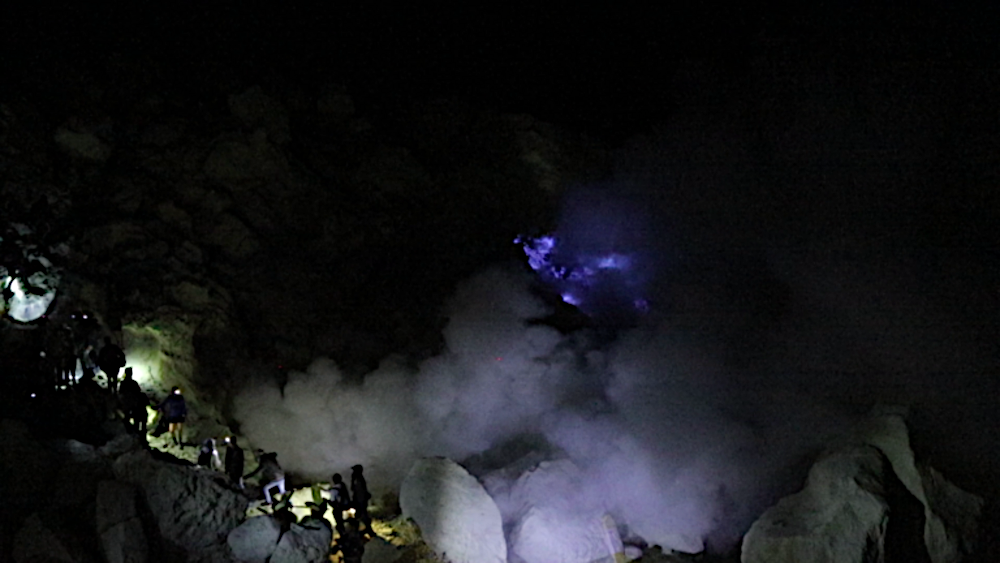
Few times in my life have I truly been mesmerized, captivated, transfixed by something like I was that night, staring in wonder and awe at the famous Blue Fire of Kawah Ijen Crater.
Luckily, a year later, I was back.
And this time, my Blue Fire dreams came true.
As with my visit to Borobudur, the Kawah Ijen trip began — cruelly — in the middle of the night. Though the fire burns 24/7/365, it’s only visible in pitch darkness, and the hike up there is a good 1.5 to 2 hours, so to view it before day begins to break requires leaving the hotel at a punishing 12:30am.
Not my ideal departure time, but you gotta do what you gotta do.
The guide and driver arrived promptly at 12:30am, and still rubbing sleep from my eyes and wishing for coffee, I stumbled out to the LandRover and we bumped and bounced for a good 45 minutes up to the entryway. The guide cautioned me to hide my DSLR and drone equipment, as the guards often try to charge extra for people who bring more than a cellphone into the crater.
“We’ll have to see, too, if anyone else is flying a drone,” the guide said. “Sometimes the rangers will come looking for people flying drones.”
(As irritating as a drone is, it’s undeniably incredible to have drone images and video — an indispensable and ever more ubiquitous photography tool.)
Getting photo equipment past the guards was not the only challenge. In fact, it was cake (just kept it in my backpack) compared to the difficulties that lay ahead.
The first was just getting to the rim of the crater, which was a good, hard, steep hike. Altitude wasn’t a problem, but with the faint wafts of sulfur fumes getting ever stronger and the chokingly thick clouds of cigarette smoke from the European hikers and the Indonesian guides (including my own), my lungs were feeling it even before we descended into the volcano. I was still getting over my cold, too, so on the way up I stopped frequently to hack, wheeze, and feel like old age and decrepitude was creeping up on me.
By three-thirty A.M., I’d reached the rim. My guide, who had smoked basically non-stop the entire way up, hadn’t even broken a sweat. I (and okay, I had 30 pounds of backpack on me) on the other hand, was drenched, my clothes were cold and clammy, and I was huffing and puffing like a marathon runner at Mile 23.
Those who feel this part of the hike is too strenuous have the option — from the gate entry to the crater rim — of taking a hand-pulled cart, which (as I huffed and puffed myself to the top!) seemed ever more tempting. Many tourists opted within the first 200 yards to take a cart, and soon vanished ahead as 2 or 3 cart guys, strong as mules, pulled them all the way to the rim. It cost about 700,000 IDR, if I recall…just under $50USD in today’s exchange rate. When you consider that this is a hefty fee for a day’s work, it’s not a bad thing to support these hard-working folks who will make your life so much easier. It also allows you to save your strength and energy for the rim-to-fire descent.
By three-thirty A.M., I’d reached the rim. My guide, who had smoked basically non-stop the entire way up, hadn’t even broken a sweat. I (and okay, I had 30 pounds of backpack on me) on the other hand, was drenched, my clothes were cold and clammy, and I was huffing and puffing like a marathon runner at Mile 23.
But the hard part hadn’t even begun.
From there, it’s a 45 minute clamber and scramble down a rough, often slippery trail to where the fire is.
And this was when the guide said, “Oh, it’s good: it’s visible. Often we get here and it’s not even possible to see it.”
At no point prior had anyone explained that seeing the Blue Fire was a possibility, not a certainty. Good to know, I thought, bent over and breathing heavily with my hands on my knees. Good to know.
Then began the descent. Nothing impossible for anyone who has done a bit of mountain hiking or hit the trail from time to time. A well-worn track zigged and zagged to a spot far below where I could see, dimly, a fuzzy patch of blue billowing in the breeze. The trail was lit by other hikers carrying flashlights or lamps, from those nearby to some far below, as small as ants.
I let the guide carry the flashlight and just followed where he stepped, and while I had a few skids and slips, had no falls or twisted ankles. It wasn’t so steep that a misstep would have sent you tumbling down several hundred feet of sheer cliff, but you’d likely break an ankle or pop a knee, and that would have been an unfortunate end to the journey.
The bluish fuzz got closer and closer and closer, until finally it was unmistakably fire. As hard as it had been, as long as I’d waited, there was a part of me that had wondered if it was worth it. I mean, how amazing could it be, right? Just blue fire.
Well, it was worth it.
Few times in my life have I truly been mesmerized, captivated, transfixed by something like I was that night, staring in wonder and awe at the famous Blue Fire of Kawah Ijen Crater.
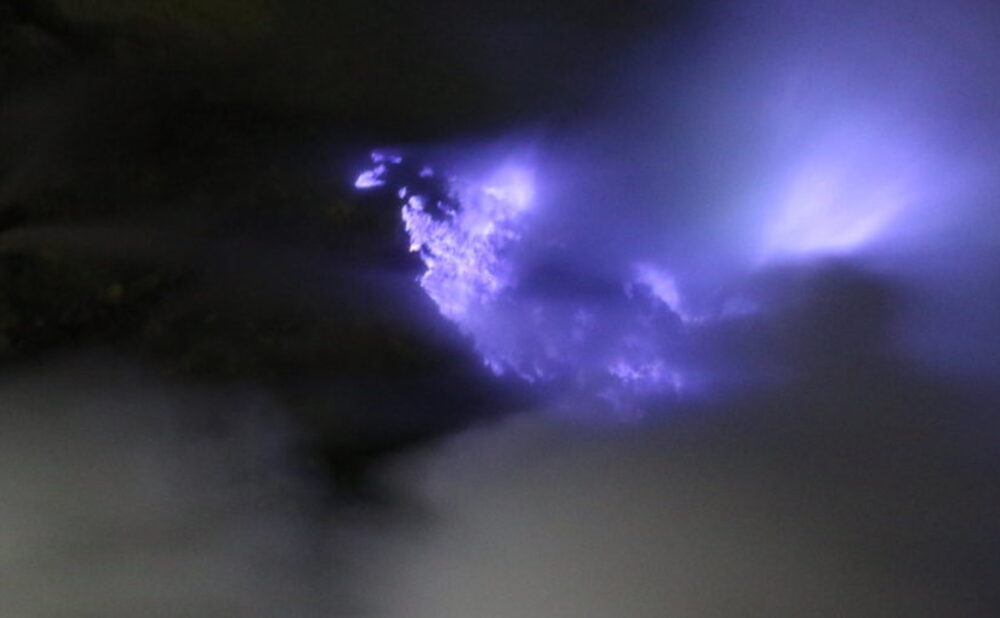
The photos don’t do it justice.
Something so magical, otherworldly, eerie, and beautiful. A patch of mountainside the size of a tennis court burning in blue flame. It was incredible.
I took photo after photo after photo, hoping some of them would come out, would do a decent job of sharing this sight with those who haven’t seen it. But I think part of the magic is that of actually being there. Having it right in front of you. Before your very eyes.
I could have stayed at the bottom of the crater until the sun came up, but two things happened that made me pull myself away.
First was the hope to get good photos of sunrise at the crater rim. At this point, it was already 4:30am, and while it was still dark, the pitch darkness had lifted and the stars were starting to fade.
Second was that the wind shifted, and the billows of toxic sulfur gas that had been heading off over the lake were now choking anyone who was dumb enough to stick around. I had been in the middle of setting up a photo when my eyes began burning and I couldn’t breathe at all. Poison gas was suffocating everyone, sending people scrambling up the mountainside for safety and breathable air. How ironic if my final moments were down here, gassed like a sewer rat by the same fire I’d waited a year to come see.
Coughing like a tuberculosis patient, I clawed for my gas mask, clamping it over my nose and mouth and unsure whether it would actually work. Suddenly I could breathe again.
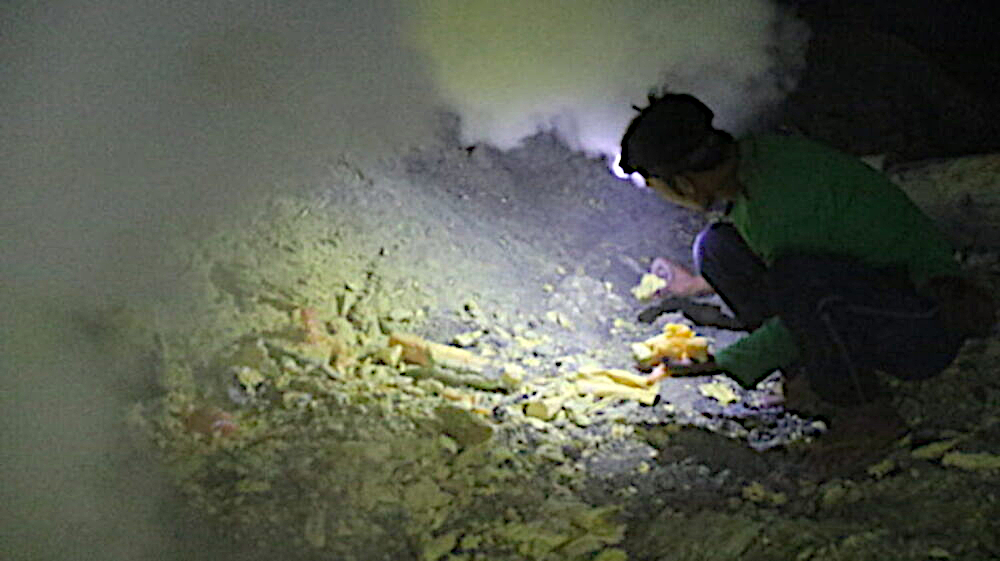
There is a darker story to this crater too, which is that the sulfur miners often work without any protection, no mask, no goggles, exposing themselves daily to fumes that over time reduce their lifespans by decades. Many die of fume-related causes in their forties and fifties, working for pennies to bring sulfur up from the crater by the bushel, often carrying 30 or 40 kilograms at a time. Selling a sulfur carving for even 10,000 IDR (about 71 cents!) can be more than they earn from the mine in a day. So I was more than happy to buy a few of these trinkets from various people selling them. (Though note: sulfur is a substance that is not allowed on the airlines, so you will likely not be able to bring these home in checked or carry-on luggage.)
Even with the mask, by this time I was coughing non-stop, my lungs producing a thick liquid that just kept coming and coming. Climbing out of the crater I had to stop frequently, hacking and coughing so deeply my sides began to hurt. Each time I stopped to rest, my guide would fire up a fresh cigarette.
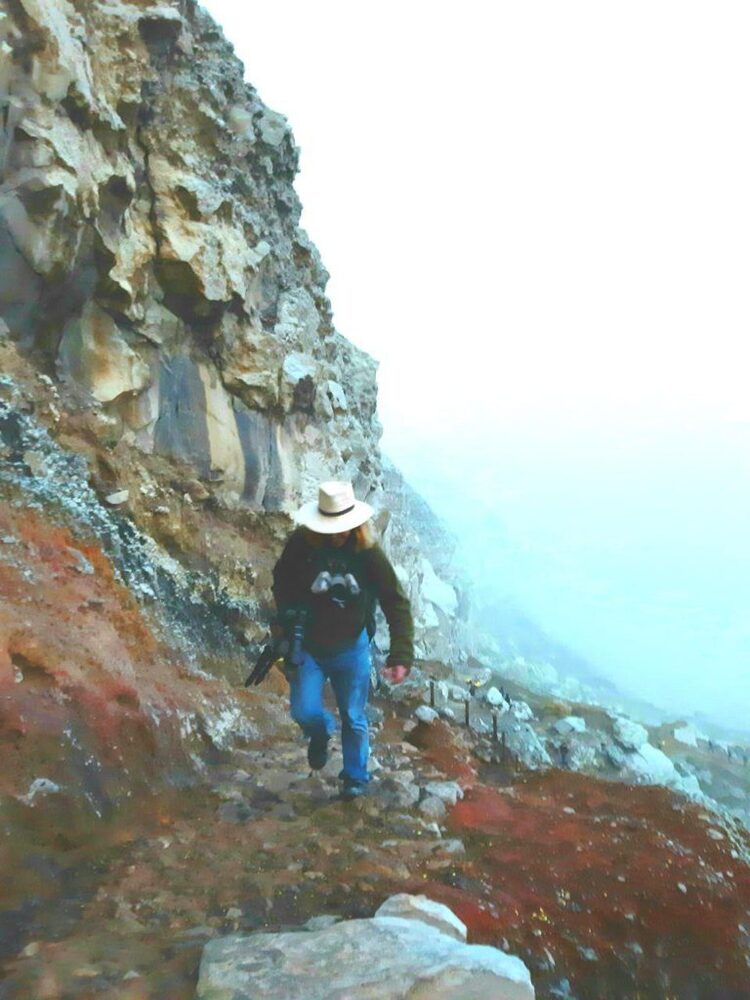
By the time I was nearing the top, a lovely gray light had illuminated the crater walls, revealing a landscape that looked almost lunar, painted with splashes of rust, ochre, and chalky white. Below the fire was no longer visible; only the smoke billowed, indicating the location. Thick gray fog obscured completely the beautiful emerald lake that I knew was right there below.
There is a darker story to this crater too, which is that the sulfur miners often work without any protection, no mask, no goggles, exposing themselves daily to fumes that over time reduce their lifespans by decades.
That was my final goal for the trip: I’d brought the drone specifically to hover it high above the lake as the sun hit the water.
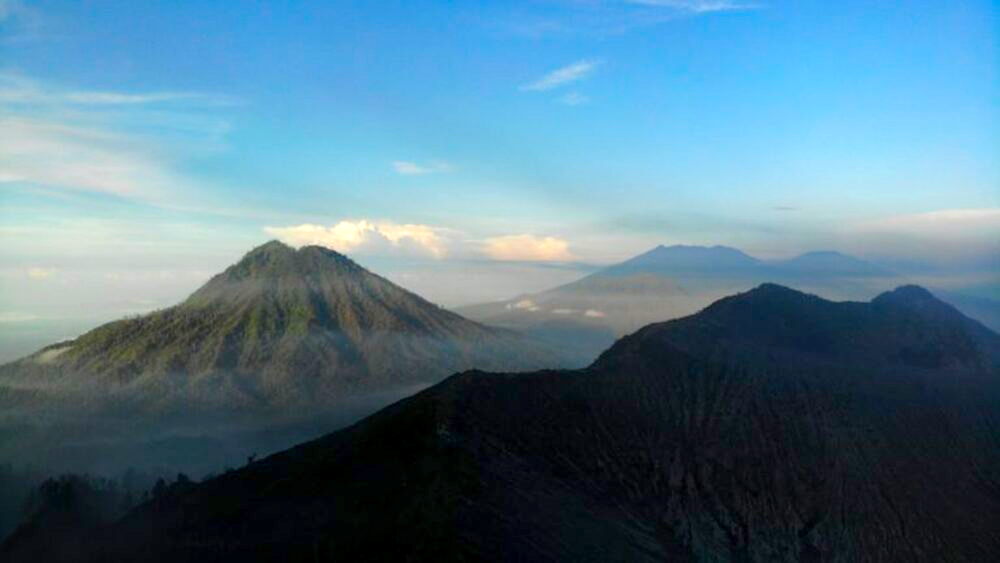
It would have been a magical finale to the incredible Ijen journey…but just like my first time coming a year ago: it was not to be.
Instead of sunshine, the clouds just kept on building and building, and the rain that had threatened to wash out the entire visit now seemed ominous again. The sun peeked out for a brief moment, but never strong enough to burn away the thick fumes and fog that were cupped in the crater like cotton in a nest.
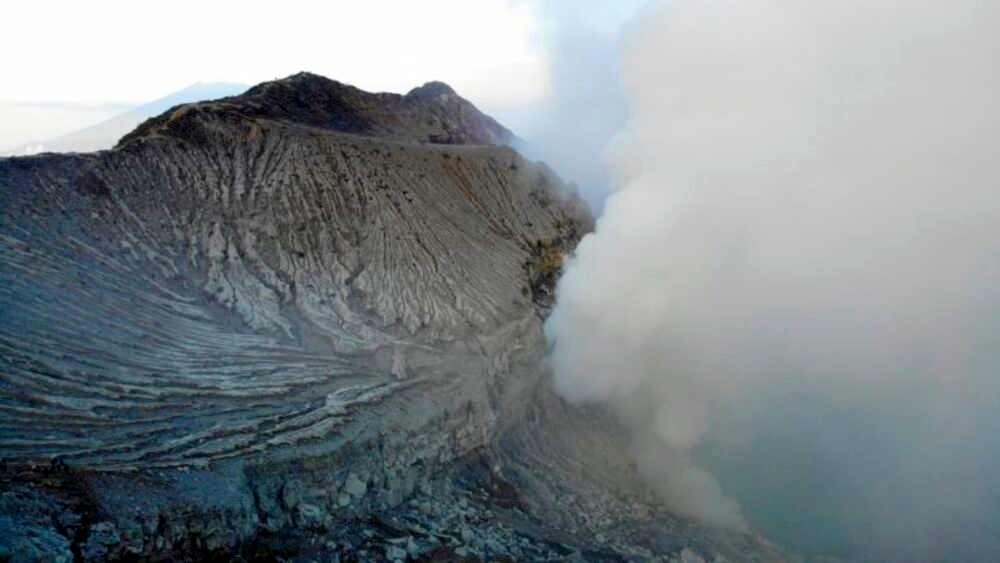
Hiking down the steep trail to the exit gate, I saw the beauty that I’d missed coming up in the darkness, and decided I’d have to come back again. This time for the emerald lake.
And if I felt up to it, another descent down into the crater. Kawah Ijen and its blue fire.

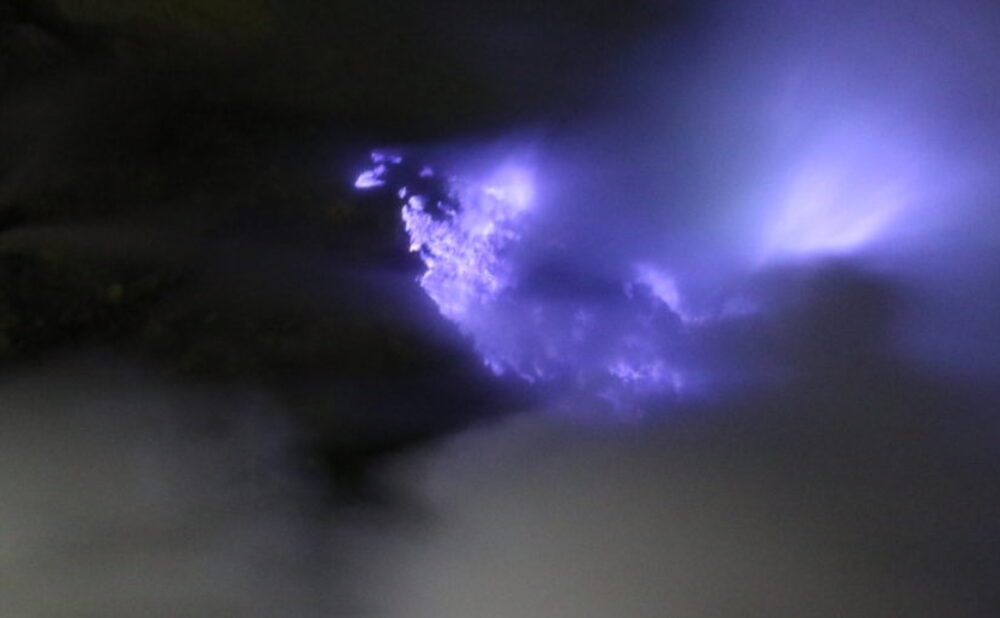
Leave a Reply